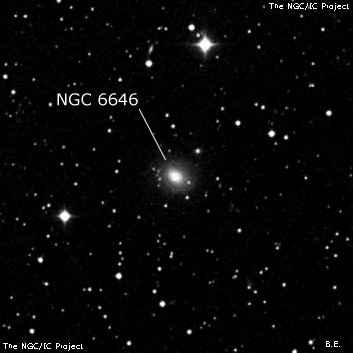
William Herschel discovered NGC 6646 = H II-907 on 26 Jun 1802 (sweep 1109) and recorded "F, S, iF." This is one of the last few "nebulae" that WH discovered and the only one that evening. He probably observed that evening solely to reach the 500 threshold for a new catalogue, although after the manuscript was submitted to the Royal Society, Caroline discovered the list only included 497 new entries. So, there were a couple of additional sweeps made in late September to bring the total past 500.
300/350mm - 13.1" (7/20/85): fairly faint, fairly small, small brighter core, diffuse halo. Forms an obtuse angle with mag 8.5 SAO 67027 3.9' NNW and mag 9.5 SAO 67032 3.3' ESE. Forms a trio with IC 1288 9' SSW and IC 1289 7.5' NE.
600/800mm - 24" (7/19/17): at 375x; fairly bright, moderately large, slightly elongated SW-NE, ~1.2'x1.0', strong concentration with a bright core that increases to a small brighter nucleus. Mag 8.8 SAO 67027 lies 4' NNW and mag 9.5 SAO 67032 is 3.4' ESE. NGC 6646 is the brightest in a physical trio with IC 1288 10' SSW and IC 1289 7.5' NE.
Notes by Steve Gottlieb